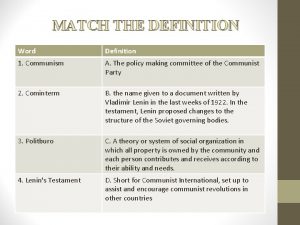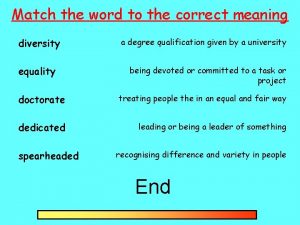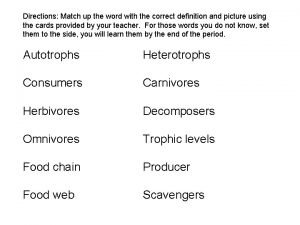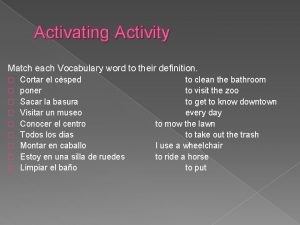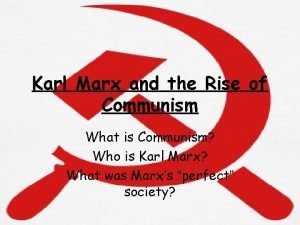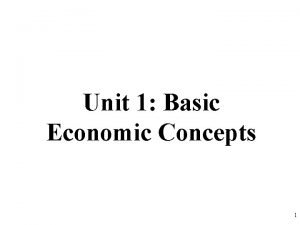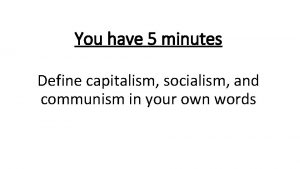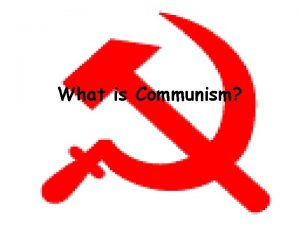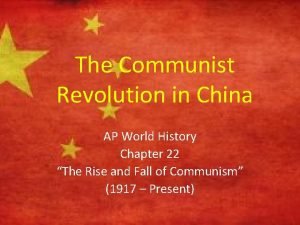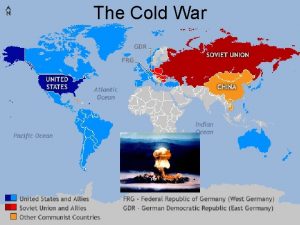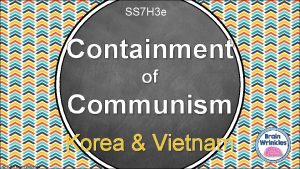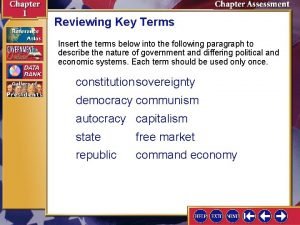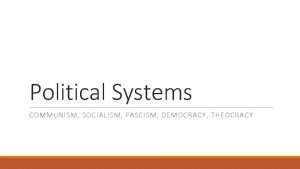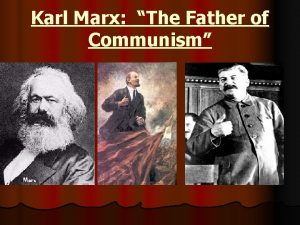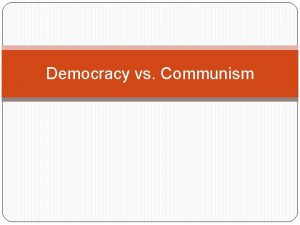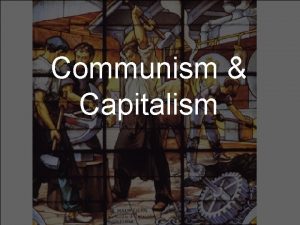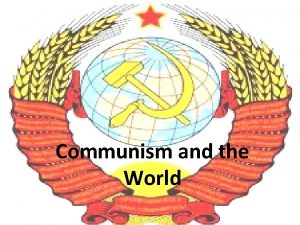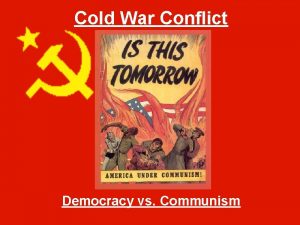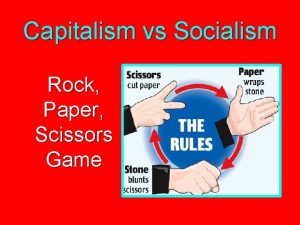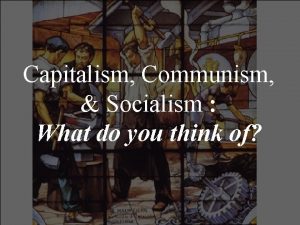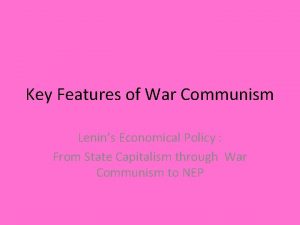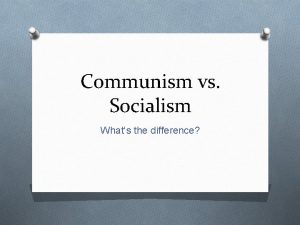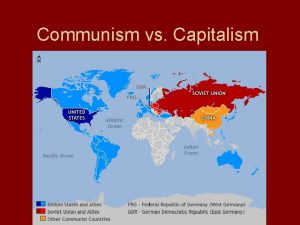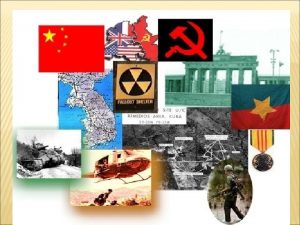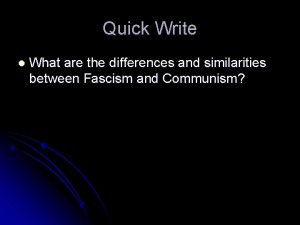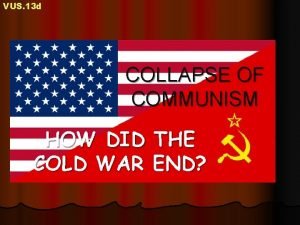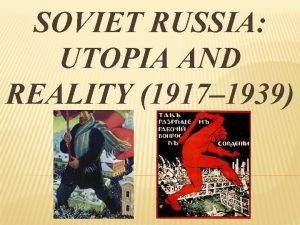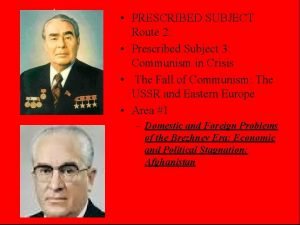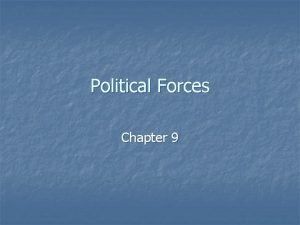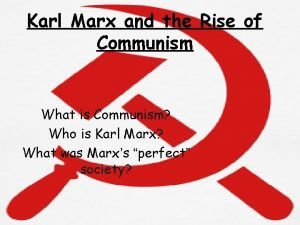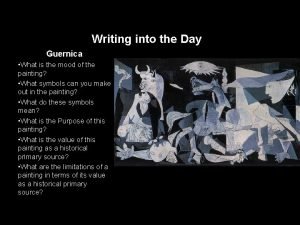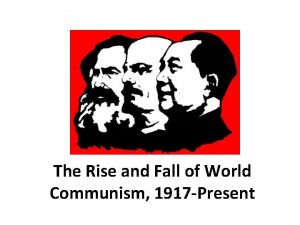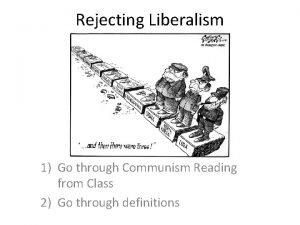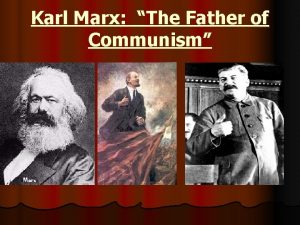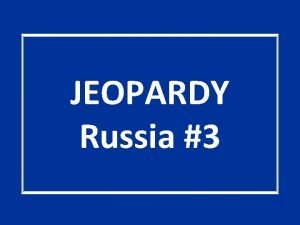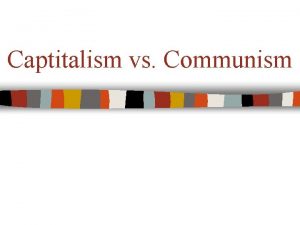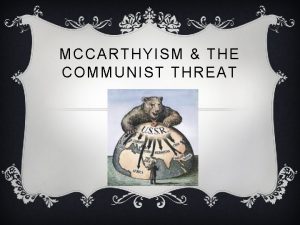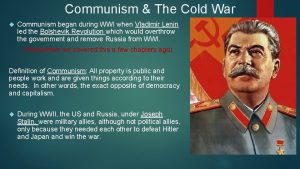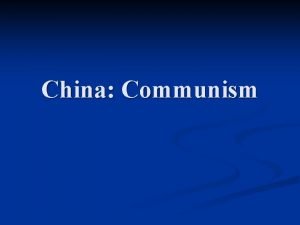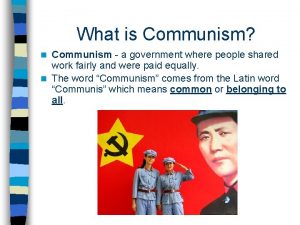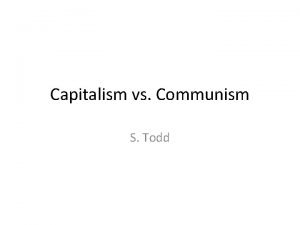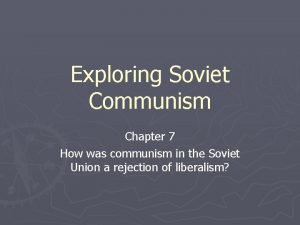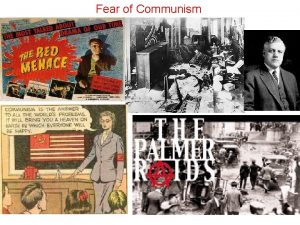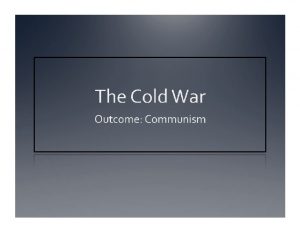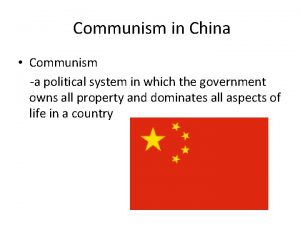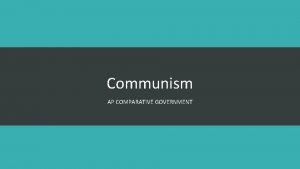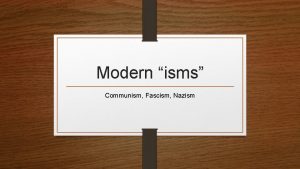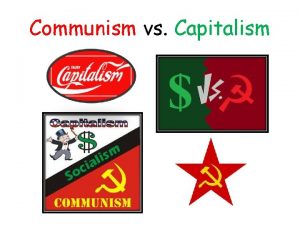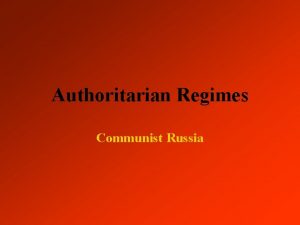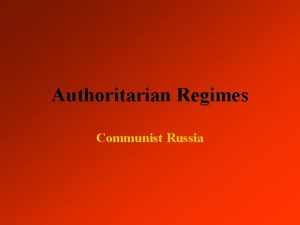MATCH THE DEFINITION Word Definition 1 Communism A



















































- Slides: 51

MATCH THE DEFINITION Word Definition 1. Communism A. The policy making committee of the Communist Party 2. Cominterm B. the name given to a document written by Vladimir Lenin in the last weeks of 1922. In the testament, Lenin proposed changes to the structure of the Soviet governing bodies. 3. Politburo C. A theory or system of social organization in which all property is owned by the community and each person contributes and receives according to their ability and needs. 4. Lenin's Testament D. Short for Communist International, set up to assist and encourage communist revolutions in other countries

Key Terms • Collectivisation – grouping farms together • Gosplan – The State Planning Authority • Kolkhoz – state collective farms • Stakhanovites – followers of Alexei Stakanov who were dedicated to hard work • NEP- New economic policy • Kulak - Rich farmer

Collectivisation in the USSR

Getting you thinking timed pair share In pairs, study the pictures of Russia on the following 12 slides, they show the economy under the Communists just before the fall of Communism, what do they tell you about the economy under this system?

Siberians line up outside a shop in Novokuznetsk, Russia

Russians must wait in food lines to get whatever goods are available in Moscow

A woman stands near the back of a queue for a market in hope

Queuing for bread

Russians waiting in food lines to get the goods are available today

Queuing in Novokuznetsk for bacon and other meat from the butcher at a state-run market

Getting the bare essentials: Shoppers and vendors in a food market in Kaluga

People stand in line with cans for food supplies in Tula, Russia

Exchanging empty vodka bottles for small change

Female miners take a break from their work in the town of Novokuznetsk

Childhood in a coal-mining and steelmanufacturing community in Siberia

Siberian men relax outside a shack in the town of Novokuznetsk

Feedback Copy and complete the following sentence: “The Russian economy under the Communists was…. ”

When I came to power I introduced NEP (New Economic Plans. These weren’t too popular but were relatively successful. • Lenin

NEP • Whilst the NEP was successful in increasing the production of grain and heavy industry, it did have its failings • It wasn’t Communist • Peasants were able to sell grain at a profit • A new class of peasants emerged = Kulaks (rich farmers)

LETS CHANGE THIS

Read the sources below and find at least three reasons why Stalin wanted to transform the Soviet economy and society. Source A – Stalin, writing in Pravda, 5 February 1931 To lower the tempo of industrialisation means falling behind those who fall behind to get beaten. But we don’t want to get beaten. The history of old Russia consisted, amongst other things, in her being beaten continually for her backwardness. She was beaten by the Mongols, Turks, Poles, Lithuanians, English, French and Japanese. She was beaten by all of them because of her backwardness, her military backwardness, cultural backwardness, political backwardness, industrial and agricultural backwardness. We are fifty or a hundred years behind the advanced countries. We must make good this distance in ten years. Either we do it, or we shall be crushed. Source B – Stalin, in an article entitled ‘Year of the Great Breakthrough’, Pravda. 7 November 1929 From small, backward, individual farming to large-scale, advanced, collective farming. The new and decisive feature of the peasant collective farm movement is the that peasants are joining the collective farms not in separate groups, but in whole villages, whole regions, whole districts, and even in whole provinces. We are becoming a country of metal, an automobilised country, a tractorised country. And when we have put the USSR on an automobile, and the peasant on a tractor, let the esteemed capitalists, who boast their ‘civilisation’, try to overtake us.

What was Collectivisation? • Collectivisation was when a group of farms came together to form one, big farm. Most common farm was the kolkhoz • This farm would be run by a committee • Everything in the farm was shared. Animals, tools and all the food was produced • The food which a collectivized farm produced would be sold to the state at a low price

• According to Source A, why does Stalin favour collectivisation?

Why? • Collectivisation was more Communist than the NEP- Everything was to be shared within the commune • It was easier to collect grain from a collectivised farm than individual farms • Agriculture was still backward in Russia - Farmers still used strip farming with wooden ploughs, Collectivisation would modernise farming • More efficient farming meant that more peasants could work in industry • Stalin wanted to avoid such famines as the winter famine of 1928 -29

IS THIS A GOOD IDEA? • I think this is a good/bad idea because….

How was it implemented? • In May 1929, Stalin announced to the Party that he intended to collectivise all the farms by 1932 -33 • At the beginning, peasants were given the option to join a collectivised farm. In exchange they were given new machinery such as tractors • However, not many joined originally. • Why do you think that was?

• When Stalin realised that not many peasants were going to sign up, he sent Party officials and the secret police to ‘persuade’ them to join • The kulaks had their machinery taken from them and it was given to the collectivised farms • Kulaks in turn were shot, deported or sent to labour camps. This was known as the ‘liquidation of the kulaks’

• https: //www. youtube. com/watch? v=Fcum. JNNX 0 qc • Try and come up with one positive and one negative thing about collectivisation.

Make a flow chart of the process of collectivisation

• • • • • Politburo Kulak Collectivisation Liquidation NEP Lenin Stalin Right wing Left wing Labour camps Communism Russian revolution Comintern Gosplan Kolkaz Trotsky Stakonivite Key word bingo

Effects of Collectivisation

Use the sources around the room to make your mind up Ways in which collectivisation was politically successful for economically successful for the government Ways in which The human collectivisation was an collectivisation economic failure cost of

Effects of Collectivisation • Many of the peasants did not want to sign up to collectivisation. In response, they burnt their crops, tools and houses and slaughtered their livestock which led to armed resistance • As a result of this, Stalin called a temporary halt to collectivisation. Collectivisation began again after the harvest was collected • In 1932, a famine struck the USSR. Stalin continued to export food to other countries during the famine

• Peasants who refused to join a collectivised farm were branded Kulaks. As a result, they were dealt with accordingly • Peasants used collectivisation as a chance to settle scores with their neighbours. If someone had wronged them, they claimed that person was a Kulak

• Which source do you think was the most reliable? Why? • Which source do you think was the least reliable and why?

Was Collectivisation a Success? • Farming methods were modernised • Grain output rose from 69 million tons in 1933 to 95 million tons in 1940 • The Kulaks, as a class, were wiped out • Stalin had complete control of the peasants and the farms • In February 1930 the Communist Party declared 50% of all peasant households collectivised

Negatives • At least 5 million people died. But can the famine be blamed on collectivisation? • Overall, at least 13 million people died as a result of collectivisation • Most of the grain collected by the State was exported to foreign countries • Up to 6 million kulaks (the most enterprising and successful peasantry) had been shot • • • 25 -30% of animals had been slaughtered by the peasantry in protest

Describe one effect that collectivization had on the USSR.

Plenary

Lenin died in 1924 • True

Kulak is a rich farmer • True

Loads of peasants wanted to sign up for collectivisation • False

Collectivisation caused a famine that killed 6 million • False 5 million

NEP was more communist that collectivisation • False – the was one of the key reasons for changing it

• FALSE – it was LENIN Stalin set up the NEPs

Grain output rose from 69 million tons in 1933 to 95 million tons in 1940 • True

Famine struck in 1933 • It was in 1932

Collective farms were run by a manager • False they were run by a committe

Machinery taken from the kulaks was destroyed • False it was given to the farms

Overall, at least 13 million people died as a result of collectivisation • True

USSR did not export • False- most of the grain was exported
 What is communism in simple words
What is communism in simple words Match each word with its meaning
Match each word with its meaning Match the two parts to complete the definition:
Match the two parts to complete the definition: Match the word with its meaning
Match the word with its meaning Match the word with the definition mug burglary
Match the word with the definition mug burglary Match the word to the correct definition
Match the word to the correct definition Match the correct meaning
Match the correct meaning Match each food chain word to its definition
Match each food chain word to its definition Match each vocabulary word with its definition
Match each vocabulary word with its definition Communism simple definition
Communism simple definition What is communism example
What is communism example Occulesic
Occulesic Communism and capitalism dbq answer key
Communism and capitalism dbq answer key Communism meaning simple
Communism meaning simple Examples of communism
Examples of communism Chinese communist party ap world history
Chinese communist party ap world history Containment
Containment Containment of communism cloze notes
Containment of communism cloze notes Reviewing key terms
Reviewing key terms Theocratic communism
Theocratic communism What are the characteristics of communism
What are the characteristics of communism Disadvantages of communism
Disadvantages of communism Democracy vs communism political cartoon
Democracy vs communism political cartoon Feudal socialism
Feudal socialism Domino theory map
Domino theory map Pretest communism and the cold war
Pretest communism and the cold war Cold war communism vs democracy
Cold war communism vs democracy Collectivism principles
Collectivism principles Rock paper scissors adam smith
Rock paper scissors adam smith Socialism v communism
Socialism v communism What is a communism government
What is a communism government Main features of war communism
Main features of war communism Whats socialism vs communism
Whats socialism vs communism Whats a command economy
Whats a command economy Communism cold war
Communism cold war What is the similarities and differences of fascism
What is the similarities and differences of fascism Communism
Communism Communism
Communism Nazism vs communism
Nazism vs communism Communism
Communism Communism
Communism Base and superstructure karl marx
Base and superstructure karl marx Trotskyism vs communism
Trotskyism vs communism What's good about communism
What's good about communism Fascism vs communism chart
Fascism vs communism chart Capitalism communism socialism fascism
Capitalism communism socialism fascism Karl marx quotes malayalam
Karl marx quotes malayalam Communism
Communism Communist vs socialist
Communist vs socialist What is socialism?
What is socialism? Joseph stalin
Joseph stalin Socialism vs communism
Socialism vs communism
